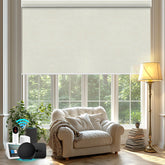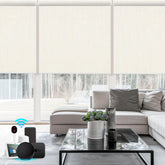Blackout Shades vs Room Darkening Shades
Looking for new window treatments? You may have already encountered two terms that are used in the window covering industry: blackout shades and room-darkening shades.
On the surface, they may appear to be the same, but they’re different.
Knowing the differences between blackout and room-darkening shades may help you best choose for your particular household needs.
Be it trying to reduce screen glare while watching your favorite show, improving sleep quality by minimizing light, enhancing privacy, or simply knowing the options available, understanding the offerings of each is imperative.
In this complete guide, we will provide you with insights on the key differences between blackout and room shades, their pros and cons, ideal use cases of each, and help in making a decision which is best for you.
What Are Blackout Shades?
Blackout shades are one of the most effective window coverings available in the market that block 100% of outside light from entering a room. It is designed to eliminate the light entering windows and enhance window privacy.
As blackout shades fully close windows, they can create total darkness at any point of the day. This is possible due to the use of opaque materials and tight-sealing designs that ensure no light can seep in.
These shades are perfect for:
- Individuals who rest during the day (shift workers)
- Parents with infants or toddlers
- Homeowners want a theater-like movie room
- People who live in noisy neighborhoods or near streetlights
Nowadays, blackout shades are more advanced than ever. Most models include motorized lifting and app integration.

What Are Room Darkening Shades?
Room darkening shades allow soft, diffused light to filter through while reducing light significantly more than standard shades. (Click here to know more.)
Their purpose is not to block light completely but to offer a balance between privacy and brightness.
These shades are best for:
- You want to reduce natural light without achieving total blackout.
- You want spaces that are dimmed yet naturally illuminated.
- You need a sense of privacy without feeling boxed in.
These shades become even more versatile and flexible, boasting an increased range of patterns, colors, textures, and fabrics.
Key Differences Between Blackout and Room Darkening Shades
Let’s simplify it:
| Feature | Blackout Shades | Room Darkening Shades |
| Light Blocking | Above 95% | 90–95% |
| Privacy | Full (day & night) | High (day), moderate (night) |
| Ideal Use | Sleeping, media rooms | Living, dining, home offices |
| Material Weight | Heavy, dense | Medium to light |
| Cost | Slightly higher | More affordable on average |
Common Materials Used In Each Type
The amount of light that comes in is dependent on the kind of material used:
Blackout Shades Materials

- Often three-layer fabric with vinyl or foam backing
- Dense polyester or acrylic blends
- Layers that block UV rays
- Heat-reflective coating
These materials work to capture light and outside noise while also blocking heat.
Room Darkening Shades Materials
- Woven polyester or cotton blends
- Mid-opacity fabric
- Layered sheer overlays
These materials work to create an even, softer glow that enhances the warmth of daylight, transforming a room into a relaxing and inviting space.
Comparison of Light Control
This is how they do it for light control:
1. Blackout Shades: Block all light. Best during the nyctophilia hours, great for shift workers and media lovers, especially during the night. Helps those sensitive to even a sliver of brightness.
2. Room Darkening Shades: Best when you want a peaceful but calm room. Dim natural light without fully blocking and maintaining the user's ability to see around the room without activating lamps.
Most shades are predicted to have customizable light with smart app adjustable settings based on the time of day.
Energy Efficiency: Which One Saves More?

There is a clear winner when it comes to choosing energy-efficient window shades.
Blackout Shades: Provide superior energy efficiency due to dense material that traps heat in winter and reflects sunlight in summer. With these, heating and cooling systems have less work to do.
Room Darkening Shades: Better for mild climates, helps regulate temperature but not as effectively. Rooms that don’t face direct sun are better for these shades.
Privacy Levels: Which Option Works Better?
During the night, with lights on, privacy is essential.
- Blackout Shades: Prevent all visibility from outside. Regardless of whether a bright lamp is on, no one is able to see inside. Most suitable for bathrooms and bedrooms.
- Room Darkening Shades: Provide moderate privacy during the daytime. However, if there are interior lights during the night, shapes and shadows may be visible from outside.
Thus, for complete privacy, blackout is the better choice out of the two options.
Best Rooms for Blackout Shades

These are the rooms where blackout shades are most beneficial:
- Bedrooms: Ensures restful sleep without disturbance.
- Nurseries: Assists babies in napping during the daytime, even when it’s bright outside.
- Home Theaters: Eliminates glare and reflections on the screen.
- Guest Rooms: Provide a hotel-style experience and ensure comfort during the stay.
Best Areas for Room Darkening Shades
Common areas where full illumination reduction is not needed are best suited with room darkening shades:
- Living Rooms: Reduces glare on TV but preserves natural light.
- Dining Rooms: Enhance ambience and foster an inviting space.
- Kitchens: Decrease excess heat and UV damage while allowing daylight in.
- Home Offices: Maintain focus while blocking harsh sunlight.
This is the optimal balance—light, but not too much.
Style & Design Options in 2025

Today’s window treatments serve a functional purpose and are fashion-forward. Know more trends in Window Treatment Trends: 2025 Guide to Window Blinds & Shades.
Blackout Shades Styles
- Streamlined roller shades
- Thermal-layered Folded Roman shades
- Insulating cellular blackout shades
- Vertical sliding door panels
- Smart systems with motorized options
Room Darkening Shade Styles
- Elegant pleated textured fabrics
- Layered dual roller shades for daylight and darkening
- Printed or patterned roman shades
- Natural woven styles with lining
Custom prints, colors, and sustainable materials will be offered, making it simple to integrate your style with your décor.
Methods of Installation
Both types of shades have two methods of installation. Read more to know how to install blinds & shades.
1. Inside Mount: Fixed within the window frame. Provides a polished, integrated appearance. Suitable for room darkening shades, but may result in light leaks for blackout shades.
2. Outside Mount: Fixed above the window frame, extending beyond it. Best for blackout shades since they prevent all gaps.
To achieve complete darkness, outside mount blackout shades are preferred, or can be combined with curtains.
Smart Features of Window Coverings

Get ready for an innovative approach to window coverings. Smart technology integrated into window shades includes:
- Voice command: Hands-free usage with Alexa, Siri, or Google Assistant.
- App usage: Open or close the shades remotely or as per a schedule.
- Light sensors: Automatic adjustment as sunlight increases.
- Battery Motors: No concealment of wires needed.
Smart-enabled models exist in both room-darkening and blackout variations. Providing convenience, energy efficiency, and remarkable innovation, these features transform your windows.
Blackout Shades vs Room Darkening Shades: Pros & Cons
In this case, let’s review the advantages and disadvantages.
|
|
Blackout Shades |
Room Darkening Shades |
|
Pros |
Complete privacy as well as light control |
Gentle light improves ambience, leaning towards nature |
|
Significant enhancement to sleeping patterns |
Fashionable, light, less bulky |
|
|
Very effective for energy efficiency |
Friendlier to the wallet |
|
|
Assistance in sound dampening |
A good mix of privacy and openness for visibility |
|
|
Cons |
It may be excessively dark for those trying to use the room during the day |
Does not eliminate all light |
|
Increased price |
Decreased privacy during nighttime |
Blackout or Room Darkening? How to Decide
Still unclear? Ask yourself this question.
- Want full obscurity and a high level of privacy? Choose blackout shades.
- Prefer gentle and cozy light filtration? Room darkening shades are perfect for you.
- Light stream issues impacting your sleep? Blackout options will fit you better.
- Do you prefer daylight or a bright and open space? → Room darkening is efficient.
- Do you require insulation from cold or heat? → Blackout gives more savings on energy.
Your daily routine, sleep patterns, and the primary function of the room should determine your selection.
More Expert Tips to Choose
- Mix and Match: Combine blackout for bedrooms and room darkening for shared areas.
- Use Dual Shades: Some styles allow switching between light filtering and blackout.
- Add Curtains: Strike a layered look with combination blackout drapes.
- Go Smart: Use automated systems with timers to control shading.
- Check Direction: Rooms with east or west-facing windows that receive harsh sunlight are better off with blackout.
Conclusion: The Best Choice for You
Tips for the selection of blackout and room darkening shades revolve around control over light, privacy, and temperature.
- For individuals who prefer blacked-out rooms for sleep, privacy, and reduced energy costs, blackout shades will be the best option.
- Those who prefer softer light, pleasant dimness, and stylish décor will appreciate room-darkening shades as their best companions.
No matter what your choice is, smarter, sleeker, and more energy-efficient options will be available.




